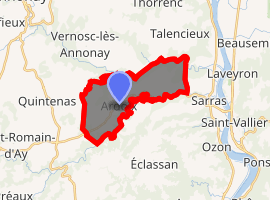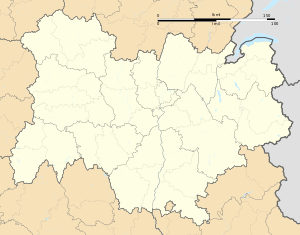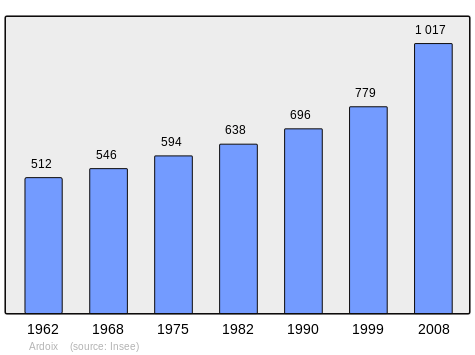Ardoix
Ardoix (Ardoís in Occitan) is a commune in the Ardèche department in the Auvergne-Rhône-Alpes region of southern France.
Ardoix | |
|---|---|
 The church and surroundings in Ardoix | |
Location of Ardoix 
| |
 Ardoix  Ardoix | |
| Coordinates: 45°11′16″N 4°44′14″E | |
| Country | France |
| Region | Auvergne-Rhône-Alpes |
| Department | Ardèche |
| Arrondissement | Tournon-sur-Rhône |
| Canton | Haut-Vivarais |
| Intercommunality | Annonay Rhône Agglo |
| Government | |
| • Mayor (2014-2020) | Sylvie Bonnet |
| Area 1 | 12.15 km2 (4.69 sq mi) |
| Population (2017-01-01)[1] | 1,262 |
| • Density | 100/km2 (270/sq mi) |
| Time zone | UTC+01:00 (CET) |
| • Summer (DST) | UTC+02:00 (CEST) |
| INSEE/Postal code | 07013 /07290 |
| Elevation | 147–397 m (482–1,302 ft) (avg. 360 m or 1,180 ft) |
| 1 French Land Register data, which excludes lakes, ponds, glaciers > 1 km2 (0.386 sq mi or 247 acres) and river estuaries. | |
The inhabitants of the commune are known as Ardoisiens or Ardoisiennes[2]
Geography
Adoix is located some 7 km west by north-west of Saint-Vallier and 14 km south-east of Annonay. Access to the commune is by the D221 road from Sarras in the east passing through the length of the commune and the village and continuing south-west to Saint-Romain-d'Ay. Apart from the village there are the hamlets of Corme, Bruas, Thoue, and Chamas. The commune is a valley between two mountain ranges and apart from the slopes of the mountains is entirely farmland.[3]
The Cance river forms a large part of the northern border of the commune as it flows east to the Rhone river. Many small tributaries of the Cance rise in the commune including the Ruisseau de la Goueille which forms the north-western border. The Ay river forms the southern border of the commune and also flows east to the Rhone.[3]
Neighbouring communes and villages[3]
History
In the gift of Quintenas made by Charlemagne to the Benedictine Abbey of Saint-Claude on 23 August 776, the Church of Saint-Didier d'Ardoix was mentioned. Also dependant on Saint Claude were the Chapel of Oriol, Saint-Alban-d'Ay, Saint-Jeure-d'Ay, Saint-Romain-d'Ay, and the chapel of Our Lady of Ay. In 1557 Ardoix, as was Quintenas, were secularized and thereafter administered by the Diocese of Vienne.
The old land of Ardoix had its chateaux and towers. Oriol, Munat, Manoha, Léorat, and le Pestrin Manoha was a fortified house and farm in medieval times. It is still a rural area today. The tower of Oriol is all that remains of the medieval castle which overlooked the gorges of the Ay. During the Hundred Years War it was sacked by soldiers. Taking advantage of the wars of religion, a criminal from Vernoux, Erard, took it and restored it to make it his lair. Farmers, frustrated by his robberies destroyed the castle to dislodge the bandit (who was hanged at Lamastre).
Administration
List of Successive Mayors[4]
| From | To | Name | Party | Position |
|---|---|---|---|---|
| 2001 | 2008 | Michel Becheras | ||
| 2008 | 2020 | Sylvie Bonnet |
(Not all data is known)
Demography
In 2009 the commune had 1,050 inhabitants. The evolution of the number of inhabitants is known from the population censuses conducted in the commune since 1793. From the 21st century, a census of communes with fewer than 10,000 inhabitants is held every five years, unlike larger towns that have a sample survey every year.[Note 1]
| 1793 | 1800 | 1806 | 1821 | 1831 | 1836 | 1841 | 1846 | 1851 |
|---|---|---|---|---|---|---|---|---|
| 300 | 517 | 761 | 765 | 800 | 757 | 854 | 800 | 863 |
| 1856 | 1861 | 1866 | 1872 | 1876 | 1881 | 1886 | 1891 | 1896 |
|---|---|---|---|---|---|---|---|---|
| 874 | 920 | 942 | 911 | 926 | 911 | 841 | 856 | 857 |
| 1901 | 1906 | 1911 | 1921 | 1926 | 1931 | 1936 | 1946 | 1954 |
|---|---|---|---|---|---|---|---|---|
| 805 | 802 | 740 | 651 | 662 | 662 | 633 | 616 | 585 |
| 1962 | 1968 | 1975 | 1982 | 1990 | 1999 | 2006 | 2009 | - |
|---|---|---|---|---|---|---|---|---|
| 512 | 546 | 594 | 638 | 696 | 779 | 947 | 1,050 | - |

Distribution of Age Groups
The population of the town is relatively young. The ratio of persons above the age of 60 years (15.9%) is lower than the national average (21.6%) and the departmental average (26.8%). Unlike national and departmental allocations, the male population of the town is greater than the female population (51.4% against 48.7% nationally and 49.1% at the departmental level).
Percentage Distribution of Age Groups in Ardoix and Ardèche Department in 2009
| Ardoix | Ardoix | Ardèche | Ardèche | |
|---|---|---|---|---|
| Age Range | Men | Women | Men | Women |
| 0 to 14 Years | 25.3 | 25.1 | 18.7 | 16.9 |
| 15 to 29 Years | 18.0 | 16.3 | 15.4 | 14.0 |
| 30 to 44 Years | 24.2 | 25.1 | 19.9 | 18.9 |
| 45 to 59 Years | 16.9 | 17.3 | 21.5 | 20.6 |
| 60 to 74 Years | 11.7 | 9.9 | 16.1 | 16.4 |
| 75 to 89 Years | 3.8 | 5.8 | 8.0 | 11.7 |
| 90 Years+ | 0.0 | 0.4 | 0.4 | 1.5 |
Sources:
Sites and Monuments
- The Tower of Oriol
- The Chateau of Manoha
- The Chateau of Muñás
- The Oratory of Our Lady of Cormes
- The Church contains many items which are registered as historical objects:
- The Rostrum Balustrade (19th century)

- A Baptismal font (19th century)

- 2 Confessionals (19th century)

- A Crucifix (19th century)

- A Pulpit with supports (19th century)

- A Stations of the Cross (19th century)

- 4 Statues and Commemorative Plaques (19th century)

- Decor of the Chapel of the Virgin

- Decor of the Chapel of the Sacred Heart

- The Rostrum Balustrade (19th century)
Ardoix Picture Gallery
 The Church
The Church The Church interior
The Church interior The Tower of Oriol
The Tower of Oriol The Chateau of Manoha
The Chateau of Manoha
See also
External links
- Ardoix official website (in French)
- Val d'Ay Tourism website
- Ardoix on the National Geographic Institute website (in French)
- Ardoix on Lion1906
- Ardoix on Géoportail, National Geographic Institute (IGN) website (in French)
- Ardoix on the 1750 Cassini Map
Notes and references
Notes
- At the beginning of the 21st century, the methods of identification have been modified by Law No. 2002-276 of 27 February 2002 Archived 6 March 2016 at the Wayback Machine, the so-called "law of local democracy" and in particular Title V "census operations" allows, after a transitional period running from 2004 to 2008, the annual publication of the legal population of the different French administrative districts. For communes with a population greater than 10,000 inhabitants, a sample survey is conducted annually, the entire territory of these communes is taken into account at the end of the period of five years. The first "legal population" after 1999 under this new law came into force on 1 January 2009 and was based on the census of 2006.
References
- "Populations légales 2017". INSEE. Retrieved 6 January 2020.
- Inhabitants of Ardèche (in French)
- Google Maps
- List of Mayors of France
- Ministry of Culture, Palissy PM07000481 Rostrum Balustrade (in French)
- Ministry of Culture, Palissy PM07000480 Baptismal font (in French)
- Ministry of Culture, Palissy PM07000479 2 Confessionals (in French)
- Ministry of Culture, Palissy PM07000478 Crucifix (in French)
- Ministry of Culture, Palissy PM07000477 Pulpit with supports (in French)
- Ministry of Culture, Palissy PM07000476 Stations of the Cross (in French)
- Ministry of Culture, Palissy PM07000475 4 Statues and Commemorative Plaques (in French)
- Ministry of Culture, Palissy PM07000474 Decor of the Chapel of the Virgin (in French)
- Ministry of Culture, Palissy PM07000473 Decor of the Chapel of the Sacred Heart (in French)
| Wikimedia Commons has media related to Ardoix. |
